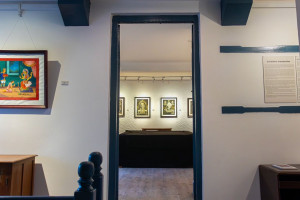Arts
Into the exquisite world of religious art
Bodhisattva Gallery’s ongoing exhibition, ‘Karunamaya’s Karuna’, attempts to shed light on and demystify the art of Buddhist statue making and paubha art.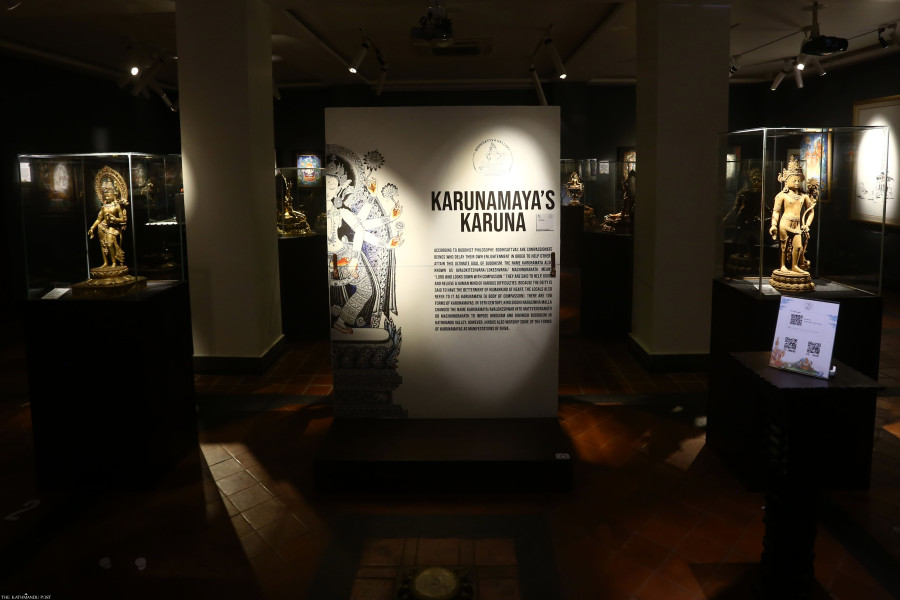
Shranup Tandukar
The beauty of art lies in its ability to impact us. To make us think, feel, see, touch, smell, taste, and experience things from a new vantage point. Art can also be unexpected; a trip to an art exhibition can be an amazing, underwhelming, resonant, nostalgic, confounding, or sometimes, a learning experience.
Religious art can be particularly cryptic to people unaware of the religious motifs and history. Paubha, a genre of traditional painting that originated among the Newa inhabitants of the Valley, is a form of religious art that can be baffling to many. While the primary deity prominently featured in paubha paintings can be familiar, the meaning and significance of the specific pose of the deity, motifs used in the painting, colour scheme, and imageries can remain enigmatic.
An attempt to shed light and demystify paubha art as well as Buddhist statues is seen at the Bodhisattva Gallery’s ongoing exhibition, ‘Karunamaya’s Karuna’. Karunamaya is also known as the Bodhisattva: Avalokiteshvara, Lokeshvara, or Machhindranath. It refers to a compassionate being who delays their own enlightenment in order to help others reach nirvana.
The exhibition features 31 paintings, eleven statues (excluding five miniature works), and two multimedia artworks. It also has a guided audio tour detailing the history, significance, and meaning behind each artwork. Curated by elder brother Prajwol Man Shakya and designed by younger brother Siddhartha Man Shakya, this art exhibition is the third show taking place at the Bodhisattva Gallery, which opened its doors in 2019. Out of the total 108 forms of Karunamaya, the exhibition only highlights 26 different forms.
The exhibition includes 14 paubha artists along with a few junior artists, while there are 15 renowned statue artists and one miniature artist.
The two Shakya brothers are the fourth generation involved in the sector of art business. While their great-grandfather and great-grandmother were both craftsmen using crystal, the family eventually steered towards creating a market for the Newa art. Most of the artworks were curated from the Shakya family’s personal collection, while a few artworks (exhibit no 6 and 35) were specially commissioned by the Bodhisattva Gallery team to further accentuate the appeal of the art exhibition.
The entire atmosphere of the art exhibition in Bodhisattva Gallery is spiritual—the exhibition is held in one giant room with no windows which eliminates any distraction and creates a sombre ambiance. The descriptions of the artworks are also minimal, devoid of the creator’s name or artist statement and consisting of simply the name of the deities and brief details. There are markings on the floor which guide visitors to the pre-designed path in tandem with the audio tour. The audio itself, narrated by Surina Shakya, weaves through the stories, origin, significance, and creator of the artworks while a tranquil Buddhist hymn plays in the background.
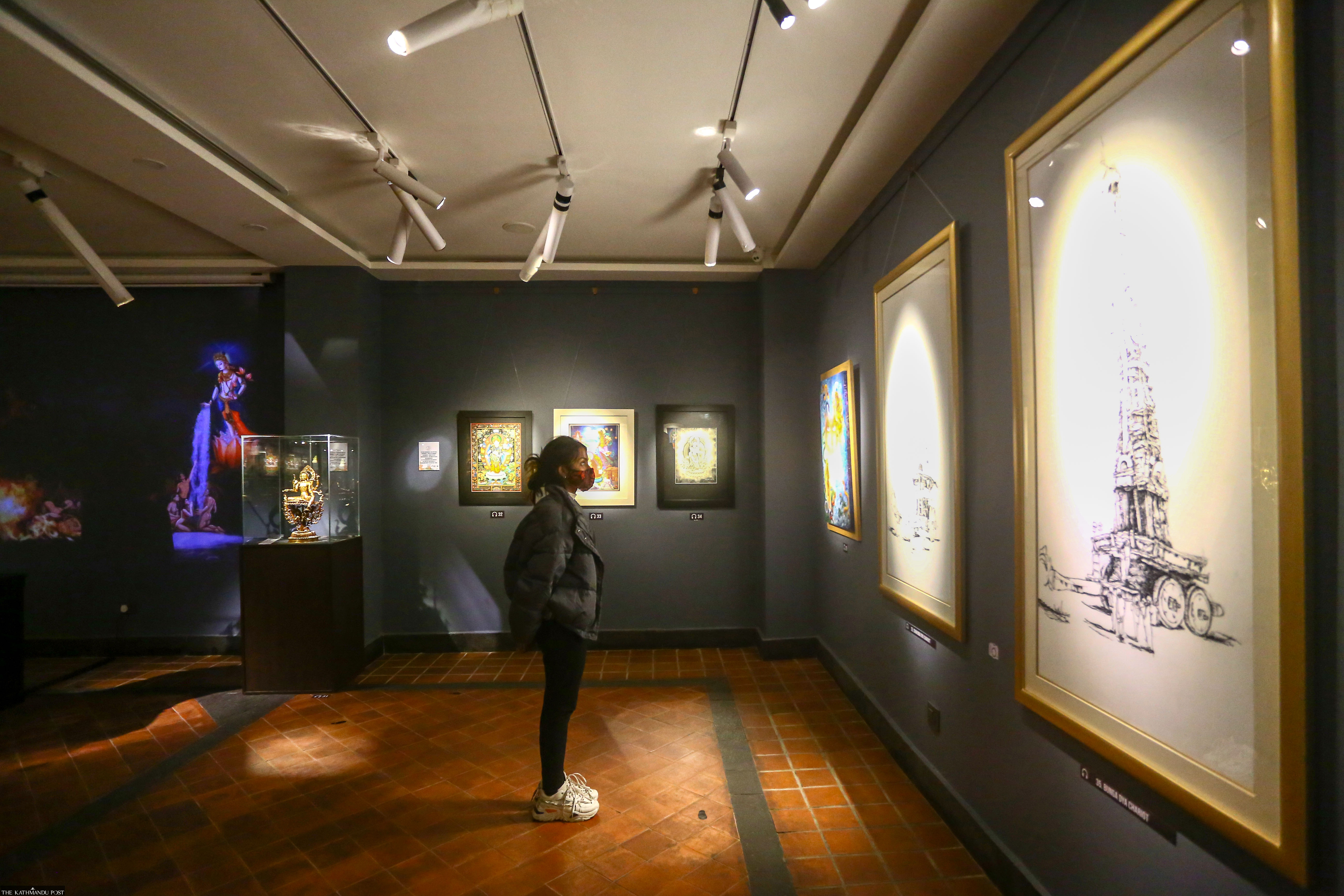
The first phase of the guided tour focuses on the statues of various Karunamayas. Most of the statues are bronze with some adorning additional precious gems while a few like the Standing Padmapani statue(exhibition no 10) are carved out of wood. The statues in varying sizes were made by master craftsmen such as Rajan Shakya, Nabin Bajracharya, Bijay Shakya, Bhim Shakya, among others, while Purna Man Shakya, the late father of Prajwol and Siddhartha Man Shakya, and the Bodhisattva Gallery team provided guidance to the artists.
The exhibit no 6 is an insightful section of the tour that focuses on the lost waxing process of making statues from Buddhist and Hindu pantheons. This traditional technique of making statues passed down from generation to generation in Shakya and Bajracharya clans was an “act of religious devotion,” further highlighting the notion that making religious art was a form of religious worship. The exhibit is divided into six different parts—from A to F—which illustrates the making of a statue of Kacheri (a form of Bodhisattva) from a block of beeswax into a finished wax statue with gold plating and further detailing. Only a few key steps in the making of a wax statue are shown and described but the exhibit offers a glimpse into the amount of collective effort and skill needed to create one statue.
Physical artwork is combined with multimedia art to provide a creative twist, which makes the religious story more compelling. In exhibit no 7, a large statue of Shakyamuni Buddha is placed in the form of a projection which plays a scene of hell where humans are suffering. In the right corner of the projection, a depiction of Avalokiteshvara is shown giving respite to the tortured souls.
The design of the art exhibition is stimulating too—the statues and paintings are not placed haphazardly but with careful consideration to create a sense of spiritual journey. Visitors start from a point near the middle of the room and then start circling the room visiting one statue after another. The statues, placed in the middle of the room, form the first phase of the exhibition, while the paintings, placed around the walls of the room, form the second phase.
The whole journey feels like a solitary pilgrimage—a circling of a stupa or temple—where you feel like you gaze into the intricacies of the artworks, learn its significance and history, pay your respects, and make your way onto another.
The painting portion of the guided audio tour begins with a paubha done by Ujay Bajracharya and sets the scene for the upcoming twelve paubha series of different Lokeshvaras and their associated months starting from Magh and ending with Poush. The audio narration sheds light on many mythical stories linked with the Lokeshvaras and also provides information on the physical statues and worship sites of the Lokeshvaras around the Valley.
The most alluring exhibit is undoubtedly no 35 which focuses on the origin and significance of Bunga dya. Consisting of three paintings and one multimedia video, all created specifically for this exhibition, the exhibit blends both audio-visual aspects to craft a compelling story of Bunga dya, who is also known as Red Avalokiteshvara, or Rato Machhindranath. Bunga dya is considered as the deity which provides rain and harvest and is the central figure worshipped in the Rato Machhindranath Jatra.
The first painting done by Raj Prakash Tuladhar and the concept designed by Prajwol Man Shakya, in this exhibit, delves into the origin of Bunga dya; how king Narendra Dev of Bhaktapur helped to bring an end to the drought that plagued the Valley in the 7th century CE. The audio tour digs deeper into the local stories and explains several symbolisms of Machhindranath jatra while the painting itself consists of the face of Rato Machhindranath statue as the central element accompanied by Karunamaya on the right, Gorakhnath on the left, and several serpents intertwining across the edges. The theme of rain and water has been incorporated beautifully as the whole painting seems to be shrouded under a perpetual rainy day.
The next two paintings differ from the rest of the paubha art style that pervades the exhibition. The black and white paintings of the chariot of Rato Machhindranath were done by Sushila Singh and they visualise yet another vital element of the Bunga dya story and Rato Machhindranath jatra.
Lastly, the exhibit also contains a chariya nritya, performed by Raju Shakya, projected onto a wall. Through the combination of different styles of paintings and a religious dance video, the exhibit craftily ties together the story of Bunga dya and the Rato Machhindranath jatra in the Valley.
The idea of incorporating an audio-guided tour with a paubha and statue exhibition was certainly a sorely needed one. While people can easily appreciate the beauty of paubha paintings, the significance of the deities illustrated and the motifs used in the paintings often elude people not well-versed in Buddhist philosophies.
Though the audio tour, which is almost 42 minutes long, can feel drawn-out, especially in the last five minutes, it is nevertheless a novel idea in the realm of Nepali art exhibition and works out well. The art exhibition presents a new perspective towards appreciating art—that you don’t always have to resonate with art, but can also learn from it.
‘Karunamaya’s Karuna’ will be exhibited until April 16 at the Bodhisattva Gallery, Pulchowk Road, Lalitpur. Prior reservations must before visiting the exhibition. (Bringing your own headphones or earbuds is highly recommended.)




 6.12°C Kathmandu
6.12°C Kathmandu
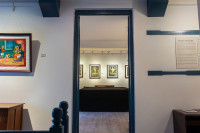
%20(1).jpg&w=200&height=120)
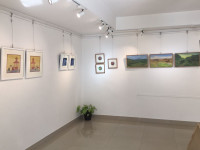
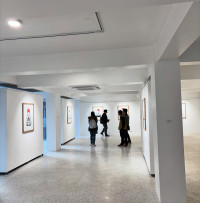
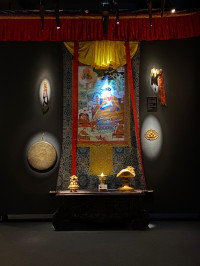
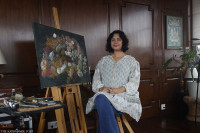
%20(1).jpg&w=300&height=200)
